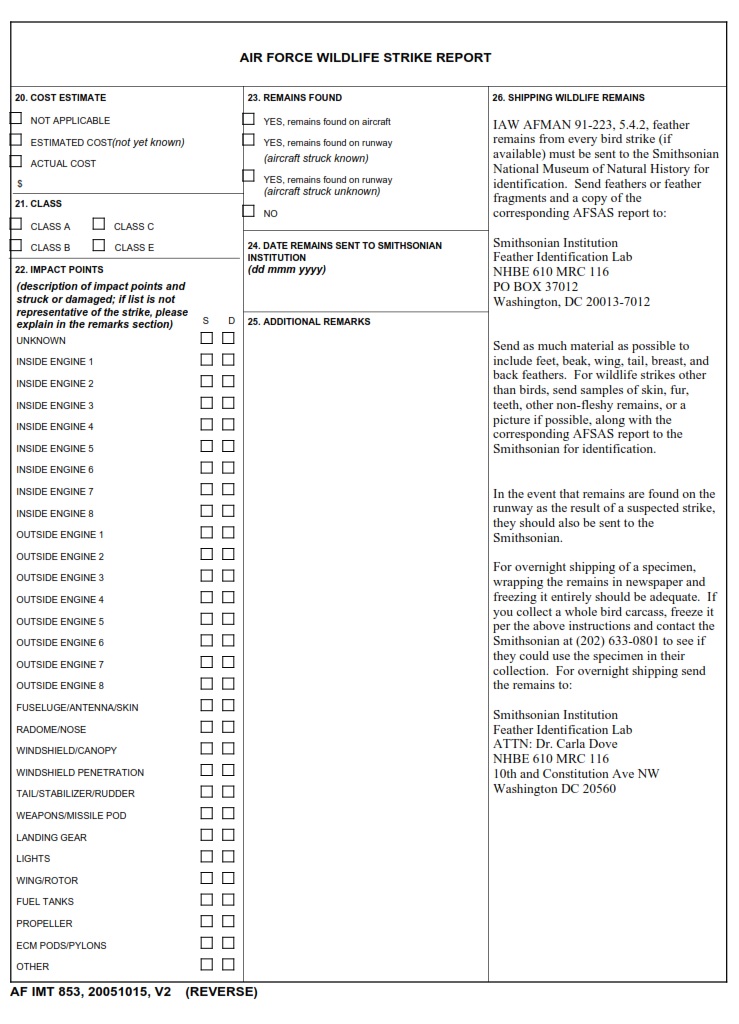AF-FORMS.COM – AF Form 853 – Air Force Wildlife Strike Report – In the vast skies where metal birds soar and engines roar, an unexpected danger lurks for our brave pilots: wildlife strikes. Imagine cruising at 30,000 feet when suddenly a flock of geese appears out of thin air, causing chaos in the cockpit. The Air Force Wildlife Strike Report, known as AF Form 853, is a crucial tool that helps us understand these baffling encounters between aircraft and animals. Join us on a journey through the untamed wilderness that collides with the high-tech world of aviation.
From majestic eagles to cunning foxes, nature’s creatures often cross paths with humanity’s greatest engineering marvels—the airplanes soaring through the sky. Behind every bird strike incident lies an extraordinary story waiting to be told—a tale of survival, resilience, and sometimes even tragedy. The AF Form 853 serves as both reporter and witness to these gripping encounters between two worlds that were never meant to collide. Prepare yourself for a wild ride as we delve into the thrilling realm where beasts meet machines.
Download AF Form 853 – Air Force Wildlife Strike Report
| Form Number | AF Form 853 |
| Form Title | Air Force Wildlife Strike Report |
| Edition Date | 10/15/2005 |
| File Size | 39 KB |
What is an AF Form 853?
The AF Form 853 is a crucial document that plays a significant role in gathering data and information regarding wildlife strikes within the United States Air Force (USAF). Designed to be comprehensive and thorough, this form aids in reporting incidents, capturing key details such as location, aircraft involved, strike severity, and any resulting damage or injuries. The primary aim is to enhance safety by analyzing trends and patterns of wildlife strikes in order to develop proactive strategies for prevention.
What sets AF Form 853 apart is its focus on environmental stewardship. It not only serves as an accountability tool for the Air Force but also contributes valuable data to scientific research. By documenting these incidents, researchers gain insights into migration patterns, habitats of concern, and species behavior around airfields. This information can then be used to implement measures that mitigate risks for both aircraft and wildlife alike.
In essence, the AF Form 853 goes beyond just recording statistics; it enables the Air Force to make informed decisions when it comes to managing wildlife hazards. The significance lies not only in enhancing aviation safety but also in promoting harmony between military operations and environmental conservation efforts – a testament to the Air Force’s commitment towards responsible utilization of airspace while minimizing negative impacts on local ecosystems.
Where Can I Find an AF Form 853?
The AF Form 853, also known as the Air Force Wildlife Strike Report, is a crucial document that plays a significant role in maintaining safety within the Air Force. So, where can you find this important form? Luckily, it’s not difficult to locate. If you are an active-duty Air Force member, you can easily access and download the AF Form 853 from the official Air Force e-Publishing website. But what about if you’re a civilian or part of another branch of the military? The good news is that most military installations have public affairs offices or environmental management offices, where wildlife strike reports can be obtained.
In addition to these options, it’s worth considering online resources as well. There are various websites providing access to government forms and documents, including the AF Form 853. These sites offer an easy way for anyone to obtain and fill out required paperwork without having to navigate complex bureaucratic channels. It’s also helpful to check with your unit’s administrator or flight safety office for guidance on obtaining this document quickly. The aim is always efficiency when it comes to reporting wildlife strikes—an essential step toward ensuring safety for both personnel and aircraft alike.
So next time you need an AF Form 853, remember that there are several avenues available for obtaining it efficiently: checking Air Force e-Publishing website if you’re in the service; visiting your installation’s public affairs or environmental management office if not; exploring online resources such as government form repositories; asking your unit administrator or flight safety office for
AF Form 853 – Air Force Wildlife Strike Report
When it comes to aviation safety, an often overlooked threat comes from the animal world. The Air Force Wildlife Strike Report, known as AF Form 853, plays a crucial role in mitigating this risk. This comprehensive report allows stakeholders to gather detailed data on bird and wildlife strikes that occur on or near airfields, helping airports and aviation authorities in implementing effective strategies to prevent future incidents.
Bird strikes alone have caused significant damage to aircraft engines and windshields over the years. By filling out AF Form 853 after each incident, Air Force personnel contribute valuable information towards identifying patterns and high-risk areas where wildlife strikes frequently occur. Moreover, this systematic recording of incidents enables wildlife experts to examine trends and develop targeted prevention measures based on scientific analysis.
One important aspect of the AF Form 853 is its ability to collect precise information about the time and location of each strike. With these details at hand, airport operators can better understand when their airfields are more prone to bird activity. Armed with such knowledge, they can take proactive measures like altering flight schedules or modifying habitats near runways to minimize potential risks. This not only ensures the safety of military pilots but also protects local fauna by reducing the likelihood of lethal interactions between birds and aircraft.

